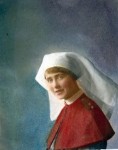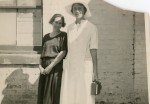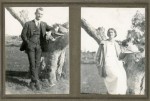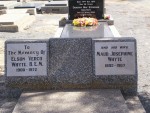FREY, Maud Josephine
Maud Josephine Frey (1892-1967)
Maud Josephine Frey (1892-1967) was born in the northern Victorian agricultural town of Tungamah, to Arnold James Frey (c1841-1897) and his wife Kate (also Cath, Catherine, Katherine) (c1859-1904).
Maud came from Swiss (possibly German) stock on her father’s side and Irish on her mother’s. Her father Arnold had been born in Switzerland to Colestin and Adelaide (Adela?) Frey. Colestin apparently came to Victoria with his family in the mid 1850s, and became a naturalised British subject in 1863 (NAA 712 1863/A1208). The family lived for a time outside Geelong, near the tiny settlement of Maude (population in 1871 21) where Colestin had a vineyard in the 1860s (Argus, 12.11.1864, p.2). Colestin subsequently moved to Melbourne and became interested in gold mining around Yea, applying for a lease as the Happy Separation Quartz Mining Company (Kilmore Free Press, 28.12.1871, p.3). He died at his home at King William St, Fitzroy in 1889, two years after the death of his wife Adelaide.
Virtually nothing is known of Kate’s background beyond her birthplace of Cork (Ireland) and approximate birthdate of 1859.
Arnold and Kate married in 1891 and by 1896 had four children – Maud Josephine, Florence (Flora), James Arnold and Francis Joseph.
In 1897, the family suffered a double tragedy with the deaths of Florence aged four, and then Arnold aged 56 (Tungamah and Lake Rowan Express, 9.12.1897, p.2; Argus, 6.12.1897). Kate was left a widow in her late 30s with three children under five. She became the proprietor of a ‘wine hall’ in Tungamah which she ran for several years before she too died in her mid forties in 1904, of heart failure (Tungamah and Lake Rowan Express, 10.3.1904, p.2; Argus, 8.3.1904, p.6).
Twelve year old Maud and her younger brothers were orphans and their lives changed dramatically. They were raised by their aunt Josephine, Arnold’s sister, who was married to James Moore, a very successful and wealthy Melbourne timber merchant. The Moore’s home, Fitzroy House, was a magnificent mansion on St Kilda Rd, Melbourne (Table Talk, 20.12.1923, p13).
Maud was sent to L’Avenir College, a school for young ladies in St Kilda run by the Mesdemoiselles Pignolet. She excelled as a student, particularly in French. In 1909, she won the college’s gold medal for ‘excellence, honours in French (prize gift of the French consul), politeness and popularity’ (Argus, 17.12.1909, p5). She had already matriculated in the Melbourne University Senior Public Examination (Argus, 21.10.1910, p5).
Despite her academic qualifications, Maud did not enrol at university. In September 1911, at the age of 20 Maud Frey began training as a nurse at St Vincent’s Hospital (registration No 154). She was ‘Catholic’, and her home address was Fitzroy House.
Maud finished her training in September 1913, and completed the examination requirements for St Vincent’s and Mont St Evins (the private hospital in East Melbourne opposite St Vincent’s, run by the same order, the Sisters of Charity) in May 1914, on the eve of war.
War Service
Maud applied to join the Australian Army Nursing Service (AANS) in October 1915. Her brother James Arnold had enlisted not long before, in August 1915, at the age of 20, with the necessary permission of his guardian, James Moore. She embarked a fortnight before he did, leaving Melbourne on 12 November 1915 on the ‘Orsova’ with other nurses and medical staff who were reinforcements for 1 Australian General Hospital in Egypt.
She reported for duty at 1 AGH on 9 December 1915. The administrative upheavals at 1 AGH of earlier in the year had ended and the hospital had been restructured. It was still dealing with sick and wounded from the Gallipoli peninsula but the numbers were decreasing as the focus of conflict and troop numbers moved to the Western Front in Europe. Nurses in Egypt were being redistributed to England, Europe and India.
Maud Frey nursed for several months at 1AGH in the Heliopolis Palace Hotel, and was then sent for a period of duty at Choubra Infectious Hospital. Located outside Cairo, this former Austro-Hungarian hospital was staffed by 1AGH staff who treated troops with diseases such as diphtheria, typhoid, meningitis, dysentery, measles and mumps.
Her original unit 1AGH had moved to France in April 1916 and on completion of duty at Choubra, Maud Frey was sent to 3AGH in Abbassia on the outskirts of Cairo. The hospital had around 1000 beds and while the numbers arriving and the work fluctuated, it was generally not heavy. Most of the troops arriving were sick rather than wounded, so the nursing was medical rather than surgical. The troops were either sent back to their units or evacuated to England for further treatment. One can assume that Frey and other nurses took advantage of the opportunities for sightseeing during her time off, although there were severe restrictions imposed by the Matron-in-Chief on their activities (Jan Bassett, Guns and Brooches: Australian Army Nursing from the Boer War to the Gulf War, 1992, p. 58).
After months of anticipation, 3AGH was relocated to England (July-September 1916). For some months it took over the Kitchener War Hospital in Brighton where Frey and her fellow nurses looked after wounded troops from the Somme. Some were “very difficult” cases and the work was “very hard” according to nurses there (Bassett, Guns and Brooches, p.58). The nurses’ living conditions were also difficult. Frey and the other nurses were quartered in a nearby school where they were “fearfully cold”. The frozen ground over which they walked to the hospital no doubt explained Frey’s chillblains, which were so severe she was hospitalised for over a month in early 1917 (Bassett, Guns and Brooches, p.58; Frey, Service Record).
After further duty treating soldiers from the front at Kitchener and then at ‘St Albans Hospital’ (probably the 1600 bed County of Middlesex War Hospital at Napsbury near St Albans), Frey was sent back to Australia on transport duty. She nursed troops returning on the ‘Runic’ which reached Melbourne in early July 1917.
Frey spent eight months in Australia. Her service record does not show her discharged in this period, and she may well have worked in one of the military hospitals or camps – a respite compared with her nursing duties in Egypt and England.
In February 1918, when she left Australia once more on active service, she again gave Josephine Moore as her next of kin. Josephine was by then a wealthy widow, and lived in Cliveden Mansions on Wellington Parade, East Melbourne.
Frey sailed from Melbourne on 28 February 1918, this time as a member of Sea Transport Section No 8. The section comprised a medical officer, matron and six sisters and staff nurses (see AG Butler, Official History of the Australian Army Medical Services 1914-1918, Vol III, Ch 14, ‘Sea Transport of Australian Soldiers’). Sea Transport Sections were raised in Australia and made round trips to England, nursing troops for the front as required on the way there and caring for repatriated sick and wounded troops on the return voyage. Inbetween, the staff were posted temporarily to one of the Australian Auxiliary Hospitals, where the repatriations were organised. While by 1918 the work was not necessarily onerous, it could be dangerous with the fear of attacks by enemy ships and submarines persistent. Sick and wounded, nurses and medical officers had been lost at sea on transport duty.
Frey reached England after seven weeks at sea on 20 April 1918. She was attached for duty at 2AAH at Southall while the return voyage was being organised. Three weeks after arriving, she sailed again for Australia, arriving in the middle of the year.
It was her last overseas duty.
After the War
Maud Frey was in Australia when the Armistice was declared on 11 November 1918. She was discharged from the AANS three weeks later on 5 December. She was 31 years old.
Although both her brothers lived in Melbourne after the war, Maud moved to New South Wales where she began working for the Bush Nursing Association. (Several East Melbourne connected army nurses turned to this area of the profession, see May Hall and Edith Cameron).
Local newspapers show Maud Frey based in various small settlements around the state including Lightning Ridge, Tarcutta, Humula, Menindie and Tottenham until early 1926. Bush nursing work could be challenging to say the least. The nurses offered the only medical care available in some areas, often to people with limited means struggling to make a living in harsh environments and ‘the backblocks’. They frequently travelled alone on horseback or in a sulky in frontier and remote areas. There could be other dramas too: the house in Tottenham refurbished for Nurse Frey burnt down a week after she arrived, destroying her furniture (£20) and worse, her supply of pharmaceuticals for her patients (£50).
In early 1926, Frey resigned as Tottenham bush nurse to be married. Her husband, Elson Varco Whyte, was the overseer of a property near Menindie where Frey had previously been stationed. The wedding took place in Trundle (near Forbes) and was conducted by the local Catholic priest, Father Sexton (Western Champion [Parkes], 11.3.1926, p.16).
Elson Whyte had also enlisted but he had had in his own words a ‘brief and inglorious’ military career (Gilgandra Weekly, 10.11.1949, p. 6). He enlisted on turning 18 in 1918 and left for active service overseas only weeks before the Armistice, and so saw no combat. He later enlisted in the Volunteer Defence Guard in early 1942.
The Whytes subsequently moved to the Wentworth area of NSW where they started a citrus orchard. Their success, said Elson, ‘was made possible by hard work and perseverance, and the assistance of my wife … My wife was a sister with the A.I.F …’ (Gilgandra Weekly, 10.11.1949, p. 6). He was proud of her war service and her contributions to the community through the Bush Nursing Association. Elson was very active in local government and mayor of Wentworth after the Second World War. He stood for the Country Party in the federal seat of Darling on several occasions with a strong anti-communist, anti-socialist stance but was never elected.
Maud Whyte died in 1967, and Elson in 1972. They were buried in the Church of England section of the Wentworth Cemetery.
Thank you to Mrs Kaaren Whyte, Maud Frey's daughter-in-law, for information about Maud's schooling in Melbourne, and to Mr Alan Whyte for the images of his grandmother Maud after the war.
Thank you to Kerry Lloyd and Rosemary Tuohey for the photograph of Maud Frey's grave in Wentworth Cemetery, NSW.
Janet Scarfe
Adjunct Research Associate, Monash
28 May 2014; updated 24 November 2016, 20 July 2017, 10 August 2017.
Can you help?
Can you correct or provide more information about this person?
Or are you able to help with this history project?
- Family stories and records including photos, documents and memorabilia?
- Stories or information in books, newspapers and on-line?
- Memorial plaques in churches and public places?
- War memorial, church, national and state archives?
If so, please Contact the East Melbourne Historical Society.




